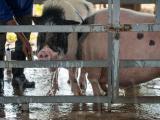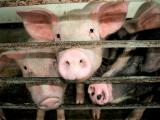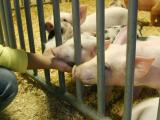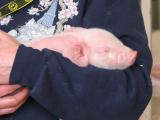Nov 12, 2010 (CIDRAP News) – The Centers for Disease Control and Prevention (CDC) today announced two human infections with a swine-related novel influenza A (H3N2) virus, both of which involved exposure to pig settings and fit the profile of the few similar cases it sees each year.
The CDC detailed the two cases, one from Wisconsin and the other from Pennsylvania, in a special notice and mentioned them in its weekly influenza surveillance report, which shows that flu activity across the nation remains at low levels.
Human novel influenza A infections are nationally notifiable in the United States, and the World Health Organization (WHO) under its International Health Regulations requires member states to report such cases to the global health community.
Earlier this week, the Russian media picked up on the US cases, based on comments from their health officials who had been notified. Some Russian media reports appeared in English-language outlets, while the infectious disease message board FluTrackers identified and translated Russian-language reports on the cases. Early word of the two cases fueled Internet speculation about a possible new pandemic strain.
For example, Russian health officials today held a press conference today to emphasize that no human-to-human spread of the novel H3N2 viruses from the US patients had been detected, according to a report from Itar-Tass, the country's news agency.
In its statement today, the CDC said the two novel H3N2 infections occurred more than 6 weeks apart, and the viruses have genetic differences that show no link between the cases. Ongoing investigations so far show no human-to-human spread. "The most likely scenario at this point is that these are two isolated cases of human infection with swine influenza viruses that, while very rare, do occur from time to time," the CDC said, adding that it fully investigates each case to detect any possible human-to-human transmission.
Laboratory analysis shows that the viruses are triple-reassortant H3N2 subtypes, common in North American pigs, that contain genes from human, avian, and swine influenza viruses. The CDC said the two novel H3N2 cases are similar to other swine-related human H3N2 infections reported in an Iowa patient in 2009, a Kansas patient in 2009, and a Minnesota patient in 2010.
Since 2005 the CDC has recorded 18 human infections with swine-related viruses, and most have occurred in people who had direct exposure to pigs.
In the latest cases, the patient from Wisconsin got sick on Sep 8, a few days after attending a state fair where pigs were exhibited. The patient was hospitalized and has since recovered. The patient from Pennsylvania, who lives in an area where pigs are farmed, got sick on Oct 24 and has also recovered.
The CDC emphasized that the swine-related flu viruses aren't transmitted through pork and that the triple-reassortant H3N2 viruses are different from the 2009 H1N1 strain and the seasonal H3N2 virus. It said that in the past the agency received about one report a year of swine-related human flu infections, but over the past few years it has averaged about three cases per year. The increase could be linked to increased lab capacity and reporting.
In other US flu developments, flu indicators in the CDC's latest surveillance report suggest that levels are up slightly, though overall activity is still low. The percentage of laboratory specimens testing positive for influenza crept up from 1.6% last week to 6.8% this week.
Hawaii, Pennsylvania, and South Carolina reported local flu activity, while 34 states reported minimal activity. Several states reported no flu activity.
One pediatric death was noted, a child from Texas whose death from an unsubtyped influenza A virus was reported during the previous flu-season week.
Of the flu specimens tested last week, 55% were the H3N2 subtype, nearly 40% were influenza B, 8% were 2009 H1N1, and the rest were not subtyped. The CDC said its tests on a selection of the virus samples suggest that the circulating strains closely match the ones including in the seasonal vaccine.
See also:
Nov 12 CDC statement
Nov 12 CDC weekly flu surveillance report
CDC flu vaccine distribution update




















